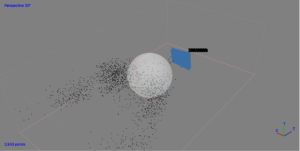ORP: Ipswich Ware Urn





Several angles of the Ipswich ware urn
Context
This object is an Ipswich ware urn that dates back to Early Medieval England. It was crafted in Ipswich, Suffolk, a port town near the site of the Sutton Hoo burial. During the seventh and eighth centuries, underwent much expansion and economic growth as a result of its role in the North Sea trading network. It is perhaps because of that growth that a group of Frisian potters were drawn to Ipswich to found a crafting enclave around the year 700, which produced ceramic wares for approximately one hundred and fifty years.
The wares that the Frisian potters produced were very economically successful, as evidenced by how far they spread across the region. One example of how prevalent these wares became in Anglo-Saxon society can be found at the archaeological site of the West Stow Village. Excavations at West Stow, which was a rural farming community, found that the proportion of potsherds that were from Ipswich wares matched the proportion of potsherds from more local wares.
One of the main things that differentiates Ipswich wares from the traditional Anglo-Saxon wares that predate them are the fact that they were made by specialized and dedicated crafters, rather than farmers who had a broader array of skills and split their labor between a variety of tasks. Additionally, the Frisian potters had better clay and tools at their disposal when crafting the wares, as crafters were often higher status than farmers. Ipswich wares were made using turntables, and were therefore more regular in form than the traditional wares that were created purely by hand. Additionally, Ipswich wares were fired in kilns, which are more easily controlled than the bonfires used for traditional firing.
Overall, the Ipswich ware urns represent a technological advancement in pottery, while also demonstrating that at least one part of Britain had recovered enough from the collapse of the Roman occupation to attract foreign crafters for long periods of time.
Process
I chose to attempt to digitally reconstruct this urn, since I felt that it would challenge me more than creating a physical reconstruction in the College’s pottery studio. The modeling software I used is called Agisoft PhotoScan, which uses a volume of photographs of an object from as many angles as possible to create a three-dimensional model of the object.
The first step was uploading the pictures of the urn into Photoscan into two separate chunks, one of the top and higher angles, and the other of the bottom and lower angles. next, I aligned the chunks, then aligned both of their photos. After that I built dense clouds from the chunks, and a mesh from the dense clouds.

A view of the ‘model’ after the building of dense chunks
At this point, I was confused because I had done all the steps that I should have done, but nothing resembling an Ipswich ware urn had seemed to take shape. In curiosity, I began to mess with the display to see if there was anything that I was missing. As it turns out, there was.

My completed digital reconstruction, perhaps?
I was able to create a digital model of the urn, but because of both its remoteness from the center of the monitor and my own lack of experience with the software made it so that I was only able to view it from one angle.
Insights
Overall, my efforts to digitally reconstruct this urn suffered from my own lack of skill, and from low resolutions of rendering. This is comparable to how efforts towards physical reconstruction could have suffered lack of skill with the medium of clay, or from inferior tools or materials.
If I had made a physical model, I would have had a very different experience which would have most likely been a more successful one. There is almost more to be learned from failure than from success, so I do not regret attempting the digital reconstruction. This reconstruction process made me appreciate how difficult it can be to accomplish something that can seem simple and linear, as well as the frustration when a final product does not fulfill its intended function-both experiences that novice potters first learning how to craft Ipswich ware urns surely experienced 1300 years ago.
Particularly, my difficulties with viewing the model impressed upon me the importance of viewing your work from multiple angles, and even from a distance if possible, in order to take as much of it into consideration as you can.
Further Reading
Blinkhorn, Paul. “Stranger in a Strange Land: Middle Saxon Ipswich Ware” Accessed May 13, 2018.
http://www.academia.edu/401957/STRANGER_IN_A_STRANGE_LAND_MIDDLE_SAXON_IPSWICH_WARE.
Fleming, Robert. Britain After Rome: The Fall and Rise: 400-1070. London: Penguin
Books, 2010.
West, Stanley. West Stow: The Anglo-Saxon Village. Ipswich, UK: Suffolk County Council, 1985